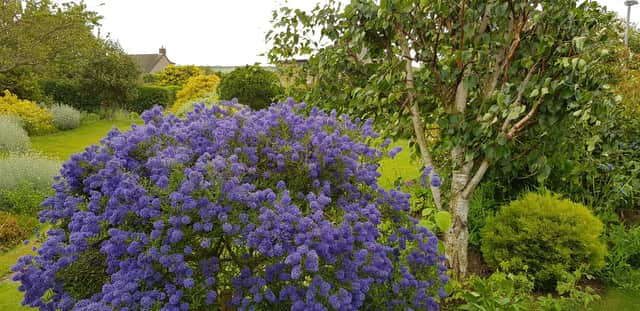GARDENING: Prepare for wind-rock damage


Where pruning is not appropriate, they are supported by a stout post and tie. This attention to detail has never been more important than in recent weeks when the pesky wind, aided and abetted by Ciara and Dennis, has been at its most destructive.
Thank goodness the taller roses were reduced by half in advance, and the shrubs with a top-heavy canopy either relieved of some growth or offered supports. Even so a Peruvian orange blossom (Choisya ternata) barely one metre high has developed loose anchorage thanks to constant buffeting by wind, and a standard Californian lilac (Ceanothus `Concha`) I thought was
Advertisement
Hide AdAdvertisement
Hide Adfirmly secured, broke moorage overnight and stood at an angle in daylight.
Far better this should happen when a plant is in a semi-dormant state rather than the full growth mode of summer, for the root system can tolerate a little disturbance at this time. As an acquaintance discovered a few years ago when she awoke to find her mature apple tree, still laden with late autumn fruit was lying at an acute angle.
The lady of the house and I responded with spades, rope and posts, to find the mature tree lying almost at ground level on one side, with part of the root plate in mid-air on the other. A hole was dug beneath the exposed roots, a rope attached to a strong upper branch of the tree, and we hauled it upright in stages. The rope was secured, holding the tree in position while support posts were driven into the ground at 45-degree angles either side of the main trunk.
Once the tree was bound to them, we watered copiously, backfilled the soil for good measure and made the ground firm. The tree survived and bore fruit the following summer.
Advertisement
Hide AdAdvertisement
Hide AdTwo winters past, a variegated elaeagnus in the mixed border went on the lean after a series of strong winds, so it received the same treatment as the old apple tree and responded with such vigorous growth last summer. The stems are attractive in winter vases and this normally keeps it within bounds, but the canopy is expanding somewhat. When May arrives I`ll be pruning it
back to obvious young shoots and breaking growth buds. That`s the best time
to prune broad-leaved evergreens.
Strong winds, changing weather patterns and diverse environmental problems are rarely out of the news headlines, and we should be concerned.
What we can do to help? For this fellow it begins in the garden, growing fruit, vegetables and ornamentals without using insecticides and fungicides. Planting to encourage a strong bird, bee and butterfly presence, and others in turn. In my own garden it amounts to growing fruit and vegetables as organically as possible without the aid of pesticides and fungicides, even though the cynic might insist that something arriving on the next gust of wind or in a shower of
rain, might spoil it all!
Advertisement
Hide AdAdvertisement
Hide AdTaking a pride in your local surroundings is part of being environmentally aware, and there are many people throughout the north region doing just that. Over the past two decades I`ve met Northumbria in Bloom action groups from Tweed to Tees dedicated to the cause. It can be a
single resident going out litter-picking or an organised group full of innovative ideas to raise the profile of their surroundings.
Our Alnwick in Bloom team has monthly meetings throughout the year and regular working group activities in between. Apart from entering the regional `Bloom` competition, we have several well-established in-house events. These target business and leisure aspects of town life and cover the whole age demographic. They include a shop window competition, children`s
paintings, giant sunflowers and the town gardens competition. Next year marks our fortieth anniversary and still going strong.
Advertisement
Hide AdAdvertisement
Hide AdI admire Alnwick Friends of the Earth initiatives including their plantings throughout the town and open-air events at The Bull-field Orchard, a community project that has developed so well in recent times. A free-entry event they`ve organised with support from Alnwick Town Council, takes place this Saturday (29th) from 1 to 4pm at The Duchess`s Community High School
building and grounds, Alnwick. It deserves a good turnout. `Plant for the Planet` does invite anyone interested to bring their wellies and plant some tree saplings on site, but that`s only part of it. There are talks by a Newcastle University researcher in Hydrology and Climate Change, and by Guy Shrubsole, a national tree campaigner. There`s also a Question and Answer session by local policy shakers, plus poetry and photography by Duchess`s School students. An environment fair with natural crafts and activities for children. Refreshments are available.